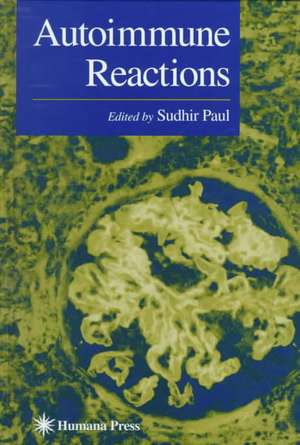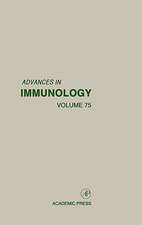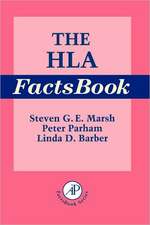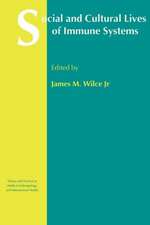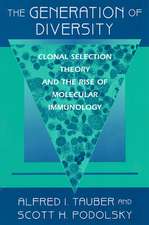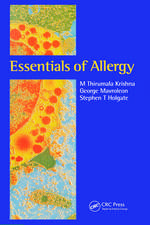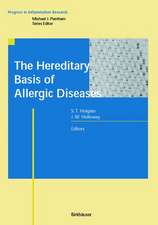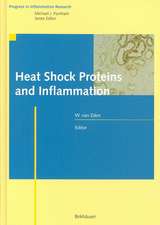Autoimmune Reactions: Contemporary Immunology
Editat de Sudhir Paulen Limba Engleză Hardback – 8 oct 1998
| Toate formatele și edițiile | Preț | Express |
|---|---|---|
| Paperback (1) | 1101.94 lei 6-8 săpt. | |
| Humana Press Inc. – 10 oct 2012 | 1101.94 lei 6-8 săpt. | |
| Hardback (1) | 1111.09 lei 6-8 săpt. | |
| Humana Press Inc. – 8 oct 1998 | 1111.09 lei 6-8 săpt. |
Preț: 1111.09 lei
Preț vechi: 1169.56 lei
-5% Nou
Puncte Express: 1667
Preț estimativ în valută:
212.60€ • 221.99$ • 175.56£
212.60€ • 221.99$ • 175.56£
Carte tipărită la comandă
Livrare economică 15-29 aprilie
Preluare comenzi: 021 569.72.76
Specificații
ISBN-13: 9780896035508
ISBN-10: 0896035506
Pagini: 438
Ilustrații: XIV, 438 p.
Dimensiuni: 152 x 229 x 29 mm
Greutate: 0.84 kg
Ediția:1999
Editura: Humana Press Inc.
Colecția Humana
Seria Contemporary Immunology
Locul publicării:Totowa, NJ, United States
ISBN-10: 0896035506
Pagini: 438
Ilustrații: XIV, 438 p.
Dimensiuni: 152 x 229 x 29 mm
Greutate: 0.84 kg
Ediția:1999
Editura: Humana Press Inc.
Colecția Humana
Seria Contemporary Immunology
Locul publicării:Totowa, NJ, United States
Public țintă
ResearchCuprins
CH. 1. Diversity of Immunological Defects in Autoimmune Disease.- CH. 2. Insights into Mechanisms of Autoimmune Disease Based on Clinical Findings.- CH. 3. Autoimmunity and B-Cell Malignancies.- CH. 4. Pathogenesis of Autoimmune Thyroid Disease.- CH. 5. Autoantigens of Sjögren’s Syndrome.- CH. 6. Autoimmunity in Patients with Essential Hypertension.- CH. 7. Autoimmune Antigen Presentation Mechanisms.- CH. 8. Induction of Pathogenic Autoimmune T-Cell and Autoantibody Responses Through T-Cell Epitope Mimicry.- CH. 9. T-Cell Antigen Receptor Repertoire in Rheumatoid Arthritis.- CH. 10. The Role of Exogenous Stimulation in Pathogenesis of Autoimmune Diseases.- CH. 11. Dysregulation of the Idiotype Network in Autoimmune Diseases.- CH. 12. The Role of Variable Region Gene Rearrangements in the Generation of Autoantibodies.- CH. 13. Autoantibodies Against Ig Immunoglobulin Framework Epitopes.- CH. 14. Autoantibodies to T-Cell Receptors.- CH. 15. Autoantibody Catalysis.- CH. 16. Is the Catalytic Activity of Bence Jones Proteins an Autoimmune Effector Mechanism in Multiple Myeloma?.- CH. 17. Kidney Damage in Autoimmune Disease.- CH. 18. DNA as Immunogen for the Induction of Immune and Autoimmune Antibody in Mice.- CH. 19. Cellular Entry and Nuclear Localization of Anti-DNA Antibodies.- CH. 20. Cell and Nuclear Penetration by Autoantibodies.- CH. 21. Alcohol, Anesthetics, and Analgesics in Autoimmune Reactivity.- CH. 22. Paraneoplastic Autoimmune Reactions.- CH. 23. The Dual Relationship Between Thymectomy and Autoimmunity: The Kaleidoscope of Autoimmune Disease.- CH. 24. Mechanisms of Action of Intravenous Immunoglobulin (IVGg) in Immune-Mediated Diseases.- CH. 25. Mucosal Immunization for Induction of Tolerance to Autoantigens.
Recenzii
"...tackles fundamental questions about how the immune system can destroy invading microbial pathogens without causing damage to itself and other "self" systems.The authoritative expert writers explore the mechanistic aspects of...autoimmune diseases...and where possible, delineate how malfunctioning immunological mechanisms can lead to clinical symptoms. They also discuss possible general mechanisms of autoimmune disease...and their current limitations as unifying explanations of the disease described. The book illustrates the type of thinking and research that should eventually permit development of palliatives and cures for autoimmune diseases."-Journal of Investigational Allergology and Clinical Immunology
Textul de pe ultima copertă
Autoimmune Reactions tackles fundamental questions about how the immune system can destroy invading microbial pathogens without causing damage to itself and other "self" systems. The authoritative experts writing here explore the mechanistic aspects of such autoimmune diseases as lupus, rheumatoid arthritis, diabetes, and autoimmune thyroid disease, and where possible delineate how malfunctioning immunological mechanisms can lead to clinical symptoms. They also discuss possible general mechanisms of autoimmune disease-e.g., molecular mimicry and dysfunctional antigen presentation-and their current limitations as unifying explanations of the diseases described. In addition, evidence for novel immunological phenomena, including antibody catalysis and the penetration of cells by antibodies, is reviewed, and their possible biological consequences are identified. The book also critically surveys the concepts and research that should eventually permit development of palliatives and cures for autoimmune diseases, as well as approaches to the long-standing problem of self-nonself discrimination by the immune system.
The comprehensive, insightful overview provided in Autoimmune Reactions constitutes the new standard reference for all practicing autoimmunologists, molecular immunologists, cellular and molecular pathologists, and clinical immunologists who need to remain at the cutting-edge of research on autoimmune disease today.
The comprehensive, insightful overview provided in Autoimmune Reactions constitutes the new standard reference for all practicing autoimmunologists, molecular immunologists, cellular and molecular pathologists, and clinical immunologists who need to remain at the cutting-edge of research on autoimmune disease today.
